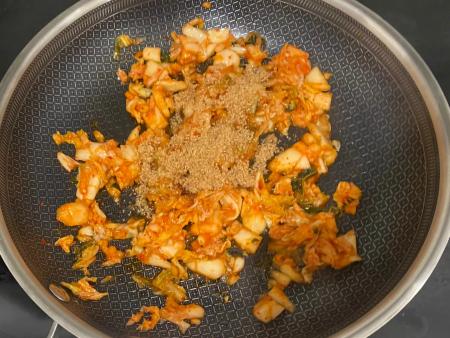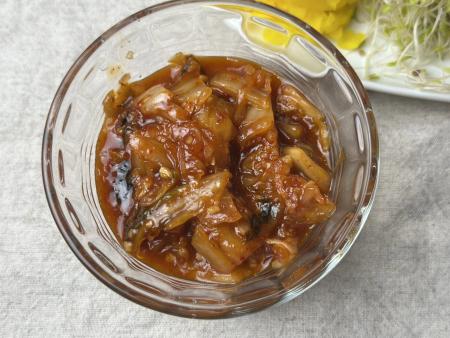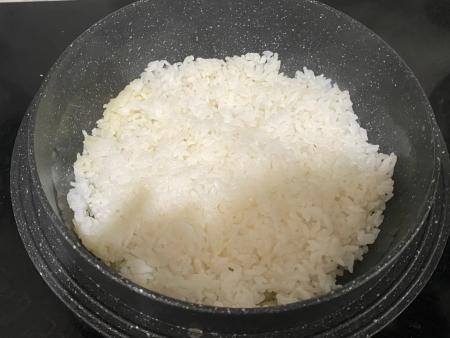Albap
"Korean fish roe rice"
(5) default ratingBy Food and Spot, April 10, 2025

ingredients
- ½ cup Flying fish roe
- ½ cup Pickled radish
- 3 Perilla leaves
- ½ cup Radish sprouts
- ½ cup Kimchi
- 1tbsp Oyster sauce
- 1tbsp Minced garlic
- 1tbsp Sugar
Trust me, Try it!
I’d been craving albap (rice with fish roe) for so long. There’s something about that combination of flavors - the salty fish roe, the spicy kick of kimchi, the crunch of radish, and the fresh bite of perilla leaves. I couldn’t find a place that really hit the spot, and I was tired of being disappointed by takeout. But then, I recently got a stone pot (dolsot), and it dawned on me: why not try making it myself? After all, albap is a simple dish, right?
Well, turns out it’s pretty easy to make if you have the right ingredients. And the best part? You can tweak it to suit your tastes. Whether you’re looking for a quick dinner idea or a fun lunch idea, albap can easily become your go-to meal. It’s also a great food idea for gatherings or meal prepping.
So, I decided to give it a try - and here’s how I made my version of albap that totally hit the spot. Keep reading to find out how you can make this delicious Korean dish at home!
Ingredients
To make this dish as close to the traditional version as possible, here’s what you’ll need:
-
Flying Fish Roe: This is the key ingredient for albap Fish roe rice. The salty, briny roe gives the rice its signature flavor. If you can’t find flying fish roe, you can substitute with other types of fish roe or even tobiko (fish eggs) for a similar effect.
-
Pickled Radish: The tangy crunch of pickled radish adds a refreshing contrast to the savory flavors of the roe and rice. Dice it up finely so it blends seamlessly into the dish.
-
Perilla Leaves: These aromatic leaves add a unique flavor that’s slightly minty and peppery. Thinly sliced perilla leaves are a great topping for the rice and bring a fresh, herbal note to the dish.
-
Radish Sprouts: These sprouts add a light, crisp texture and a subtle peppery taste that complements the other ingredients. You can find them in most Asian grocery stores, but they’re optional.
-
Kimchi: The spicy and tangy kimchi brings the perfect amount of heat and fermented depth to the dish. It balances the rich flavors of the roe and rice, making each bite a little more exciting.
-
Oyster Sauce: Just a splash of oyster sauce adds an umami kick to the stir-fried kimchi, enhancing its savory depth.
-
Minced Garlic: A little bit of garlic goes a long way in this dish, bringing a rich aroma that makes the kimchi even more flavorful.
-
Sugar: A small amount of sugar helps balance the acidity and spice of the kimchi and enhances the overall flavor profile.
How to Make it
Making albap is relatively straightforward, but it does require some prep work to get everything just right. Here’s how to prepare this delicious dish step-by-step.
Step 1: Stir-fry the Kimchi
Start by cutting up the kimchi into small pieces. You don’t want big chunks because the goal is to stir-fry it so that it blends well with the other ingredients. Toss the kimchi in a pan with a little oil, oyster sauce, sugar, and minced garlic. Stir-fry it over medium heat until it smells fragrant and the kimchi softens a bit. You want to bring out the depth of flavor in the kimchi while mellowing out its sharpness.


Step 2: Prep the Other Ingredients
While the kimchi is cooking, dice up the pickled radish nice and small. You don’t want huge pieces of radish; they should blend well into the dish, adding a burst of tanginess without overpowering the other flavors.
Next, slice the perilla leaves into thin strips. Perilla leaves are essential for this dish, as they bring an herbal freshness that balances out the other rich and savory flavors.

Step 3: Prepare the Stone Pot (Dolsot)
Once the kimchi is done, it’s time to move on to the rice. Grab your dolsot (stone pot), and brush a little sesame oil on the bottom. This will give the rice a nice, slightly nutty flavor and help it crisp up at the bottom of the pot. The crispy rice that forms at the bottom of the stone pot is the best part!
Now, scoop in some freshly cooked rice. You’ll need enough rice to fill the pot, but don’t overstuff it. The rice is the base of the dish, so make sure there’s enough room for all the toppings you’re going to add.


Step 4: Add the Toppings
Now comes the fun part - assembling the albap! Add all your prepped toppings on top of the rice. Start with the stir-fried kimchi, then add the pickled radish, perilla leaves, and a handful of radish sprouts if you have them. Don’t forget to top it off with a generous helping of flying fish roe. This is the heart of the dish and gives it that signature taste.

Step 5: Add Seaweed Flakes (Optional)
If you have seaweed flakes (called gim in Korean), sprinkle them on top for an extra touch of flavor. This step is optional, but seaweed adds an additional layer of umami and a subtle crunch to the dish. It’s also a great way to add a visual pop to your albap.
Step 6: Stir-Fry in the Pot
This is where the magic happens. Place the dolsot back on the stove over low heat, and stir everything together, almost like stir-frying it in the pot. The heat will help the ingredients meld together, and the rice at the bottom of the pot will begin to crisp up. The result is a delicious, slightly crunchy, and savory dish that you can enjoy right out of the stone pot.
This was totally my kind of fish roe rice - made with what I had on hand and using simple ingredients that I already had in my pantry. It wasn’t perfect, but after craving it for so long, it really did hit the spot.

Enjoying Your Albap
While albap is delicious on its own, there are so many ways to enjoy it. You can pair it with a warm bowl of soup, such as kimchi jjigae (kimchi stew) or miyeok-guk (seaweed soup). Albap also goes wonderfully with side dishes like pickled vegetables, grilled fish, or even a simple salad.
Try making albap the next time you’re craving something savory, refreshing, and satisfying.
Trust me, once you make it yourself, you’ll be hooked. And who knows? It might just become your new favorite food.
Leave a comment
Comments
No comments yet.